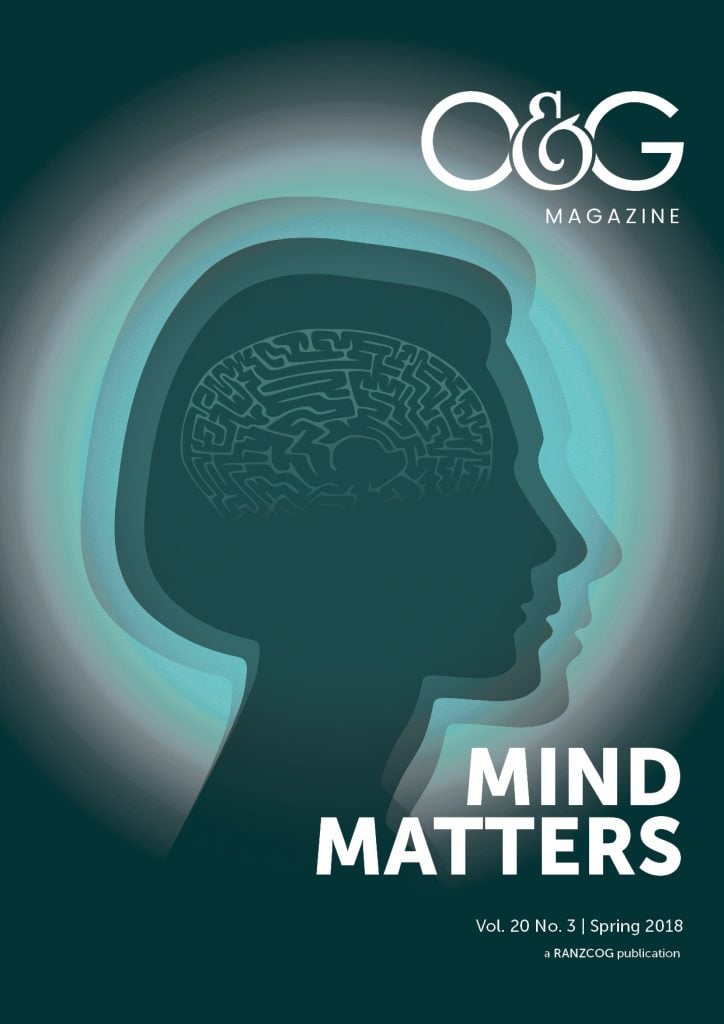Perinatal mental health difficulties related to depression, anxiety and trauma are more common than often thought. Such difficulties are likely to recur in other pregnancies, can become chronic and have long-term consequences for the mother, her infant and relationships with others. Stressful childbirth events have been found to contribute to poor maternal mental health and have been associated with symptoms of post-traumatic stress disorder (PTSD).
Although PTSD symptoms are characteristic of anxiety disorders, the latest edition of the Diagnostic and Statistical Manual of Mental Disorders (DSM-5) placed PTSD into a new class of ‘trauma and stress-related disorders’.1 Several changes to the diagnostic criteria for PTSD were made. These changes included modification of the A1 stressor criterion, which now requires exposure to ‘actual or threatened death, serious injury or sexual violation’.2 Such exposure may be direct, witnessing, learning that a significant other was exposed to trauma, or indirect (through the course of one’s professional role). Determining the extent to which a stressor is traumatic may be a highly subjective process. However, numerous studies show that even common childbirth events can be experienced as traumatic. As a consequence, women may: persistently re-experience the event through nightmares or flashbacks (Criterion B); avoid trauma-related stimuli (Criterion C); have worsening negative thoughts or feelings (Criterion D); or trauma-related arousal, such as irritability, hypervigilance or difficulty concentrating (Criterion E). These symptoms need to persist for at least one month, create distress or functional impairment and not be due to other causes.3
While the majority of births are not traumatic, two to six per cent of women meet the diagnostic criteria for PTSD following childbirth. However, many women report symptoms of trauma following childbirth. Rates of trauma symptoms range from 21 per cent in the Netherlands,4 33 per cent in Australia5 and 34 per cent in a US sample.6 A high proportion of women experiencing trauma are also likely to report co-morbid anxiety and depressive symptoms.
Factors contributing to trauma symptoms
Differences between the expectation and reality of childbirth may contribute to trauma. Distressing experiences during labour and birth often relate to interpersonal factors, pain and adverse clinical outcomes. Longitudinal studies examining psychological trauma after childbirth found a direct relationship between perceptions of poor technical and interpersonal care and development of trauma symptoms.7 Negative birth experiences associated with perceived poor care during labour and birth include, disrespect or neglect by maternity staff, attitudes and behaviours of caregivers that inhibit a woman’s choice and/or control, and high levels of obstetric intervention.8 The woman’s world view is shaken when expectations of constancy, fidelity and support are replaced with actual or perceived harm.9
Consequences
Consequences of birth-related trauma include debilitating anxiety symptoms and panic attacks, depression and suicidal thoughts, marital and family breakdown, sexual dysfunction, and emotional detachment from the baby. Obsession with seeking answers about the traumatic episode, flashbacks and nightmares, hypervigilance with regard to the baby, and social withdrawal are consistently reported by women who experienced a distressing birth.10 Some women also report fear of becoming pregnant, which contributes to a lack of intimacy and conflict with partners, and voluntary infertility.
Women who have experienced a traumatic childbirth tend to ‘reframe’ birth as frightening and dangerous. Some women may choose to not have more children or request an elective caesarean section for subsequent births.11 Women who do become pregnant again report sleep difficulties, depression, suicidal thoughts and panic attacks, particularly when attending maternity appointments. Conversely, becoming pregnant again can provide opportunities to develop new coping strategies. Some women have reported that, in a subsequent pregnancy, strategies such as proactive planning, use of a birth plan and seeking supportive and empathetic care providers, helped them to regain a sense of control during pregnancy, labour and birth.12
Psychological and psychosocial interventions
There has been little systematic research into early interventions to reduce or prevent acute trauma symptoms in childbearing women. A recent Cochrane Review of ‘debriefing’ to prevent postpartum depression reported variable outcomes.13 Of the seven included studies, not all specifically targeted women at risk. Although ‘debriefing’ is intended to prevent anxiety disorders such as acute stress reactions and PTSD, the main outcome measure in many studies was depression. Debriefing interventions are also not effective for women with serious post-traumatic reactions or serious mental distress. The authors suggest that women may require considerable time to process their distress.
A major challenge in offering counselling and emotional support to new mothers is the availability of trained staff. Our work has evaluated the feasibility of a midwife-led counselling intervention, with new mothers randomly assigned to receive counselling or an active parenting support group. At three months postpartum, PTSD total symptom and depressive symptom scores were reduced for women in the counselling support group, but, overall, there were no significant differences between groups. Mothers receiving either counselling or parenting support reported high or very high satisfaction with the interventions offered by midwives.14 Given the inconclusive nature of research to date, but potential significance of outcomes, further research in this area is needed.
The transition to motherhood is complex. Birth-related trauma symptoms may be exacerbated by the complex intersecting issues experienced by women during pregnancy and postpartum. Sensitive personal issues, such as relationship conflict, domestic violence, previous sexual assault and a history of childhood abuse, are rarely addressed in pregnancy and may adversely affect women’s abilities to cope during labour.15Furthermore, psychological issues – such as grief and loss associated with fetal or neonatal death, illness or disability, loss of a hoped-for normal birth, and processing the birth experience – can be overlooked in fragmented service models where the health professional present during labour and birth is not the person providing immediate or postpartum care. Current fragmented models of maternity care diminish the likelihood of health professionals ‘knowing’ a woman and responding effectively to her needs over time. Even though many women would like more assistance, problems arising from childbirth are frequently not discussed and few women receive the mental health help they need.
WHO16 recommends the integration of maternal mental health into all health services received by childbearing women. However, the attempted integration of specialised perinatal mental health services into maternity care has met with mixed results. Although there is a reported increase in referrals to these services, assessment may be based on a single screening or presence of risk factors. As Matthey et al argue, mental health symptoms identified by various screening and diagnostic tools cannot be easily distilled from the significant psychosocial and physiological changes of pregnancy and postpartum.17 The new Mental Health Care in the Perinatal Period: Australian Clinical Practice Guideline18 aims to improve prevention and early detection of antenatal and postnatal depression, anxiety and psychosocial risk through better screening, referral and treatment for expectant and new mothers. However, we argue that maternity care providers need to establish a therapeutic relationship with women in early pregnancy, undertake psychosocial risk and mental health assessments at multiple points, and respond to the changing needs of women throughout the perinatal period. Providing women with a ‘known’ caseload midwife has the potential to minimise childbirth trauma. Caseload midwifery routinely integrates mental health and psychosocial risk screening, and support for women and families throughout pregnancy, labour, birth and postpartum. A Cochrane meta-analysis of 15 RCTs, with over 17,000 participants, unequivocally demonstrated that women receiving caseload midwifery care were more likely to have a spontaneous vaginal birth, require less pain relief and have fewer adverse outcomes,19 thereby minimising the likelihood of a traumatic birth.
Childbirth trauma is complex and multifactorial. Caseload midwifery offers a fresh and potentially cost-effective approach to preventing and detecting risk for trauma and development of perinatal mental health disorders. Caseload midwifery frames the mental health challenges women may experience in pregnancy, birth and early motherhood as a physiological and psychosocial transition. A midwife who is known and trusted can detect mental health and psychosocial risk in a timely way and respond within the context of a woman’s maternity care.
References
- American Psychiatric Association (2013). Diagnostic and statistical manual of mental disorders (5th ed.). Washington DC.
- American Psychiatric Association (2013). Diagnostic and statistical manual of mental disorders (5th ed.). Washington DC.
- American Psychiatric Association (2013). Diagnostic and statistical manual of mental disorders (5th ed.). Washington DC.
- Olde E, van der Hart O, et al. Post-traumatic stress following childbirth: a review. Clin Psychology Review 2006;26(1):1-16.
- Alcorn K, O’Donovan A, Patrick J, et al. A prospective longitudinal study of the prevalence of post-traumatic stress disorder resulting from childbirth events. Psychological Medicine 2010;40(11):1849-59.
- Soet J, Brack G, DiIorio C. Prevalence and predictors of women’s experience of psychological trauma during childbirth. Birth 2003;30:36-46.
- Maggioni C, Margola D, Filippi F. PTSD, risk factors and expectations among women having a baby: a two-wave longitudinal study. J Psy Obstet & Gyne. 2006;27(2):81-90.
- Beck C. Birth trauma: In the eye of the beholder. Nurs Res. 2004; 53(1):28-35.
- Beck C. Birth trauma: In the eye of the beholder. Nurs Res. 2004; 53(1):28-35.
- Fenwick J, Gamble J, Creedy D, et al. Women’s perceptions of emotional support following childbirth: a qualitative investigation. Midwifery 2012;29(3):217-224.
- Fenwick J, Gamble J, Creedy D, et al. Women’s perceptions of emotional support following childbirth: a qualitative investigation. Midwifery 2012;29(3):217-224.
- Gamble J, Creedy D. A counselling model for postpartum women following distressing birth experiences. Midwifery 2009; 25(2):e21.
- Bastos M, Futura M, Small R, et al. Debriefing interventions for the prevention of psychological trauma in women following childbirth. Cochrane Database of Systematic Reviews 2015; Issue 4. Art. No.:CD007194. DOI:10.1002/14651858.CD007194.pub2.
- Fenwick J, Gamble J, Creedy D, Barclay L. Women’s experiences of PRIME midwifery counselling intervention. Women & Birth 2011;24(Supp 1):s11-12.
- Slade P. Towards a conceptual framework for understanding post-traumatic stress symptoms following childbirth and implications for further research. J Psy Obstet Gyne 2006; 27(2):99-105.
- World Health Organization. Depression and Other Common Mental Disorders: Global Health Estimate. 2017 WHO: Geneva.
- Matthey S, et al. Variability in use of cut-off scores and formats on the Edinburgh Postnatal Depression Scale – implications for clinical and research practice. Arch Womens Ment Health 2006; 9(6):309-315.
- Austin M-P, Highet N, Expert Working Group. Mental Health Care in the Perinatal Period: Australian Clinical Practice Guideline. 2017; Centre of Perinatal Excellence.
- Sandall J, et al. Midwife-led continuity models vs other models of care for childbearing women. Cochrane Database Syst Rev. 2016;4:CD004667.







Leave a Reply